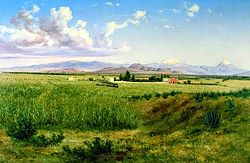José María Velasco Gómez
José María Velasco Gómez | |
|---|---|
 Self-Portrait, 1894, Museo Nacional de Arte | |
| Born | José María Tranquilino Francisco de Jesús Velasco Gómez Obregón 6 July 1840 |
| Died | 26 August 1912 (aged 72) Villa de Guadalupe, Mexico City, Mexico |
| Nationality | Mexican |
| Education | Academy of San Carlos |
| Known for | Painting, landscapes and portraits |
| Notable work | El valle de México |
José María Tranquilino Francisco de Jesús Velasco Gómez Obregón, generally known as José María Velasco, (
Career

Velasco studied art at the Academy of San Carlos under the professor of landscape, Italian Eugenio Landesio, who began teaching at the academy in 1855.[2] Landesio raised landscape painting in Mexico to high art, and articulated theories of composition that he implemented in his landscapes. Velasco is his most famous pupil, who following his mentor's departure in 1877, dominated Mexican landscape painting and gained an international reputation, whose works became part of collections in the U.S.[3]
Velasco's production can be classified into three periods: The academic years, from 1860 to 1889, that include La Plaza de San Jacinto en San Ángel, Las montañas de la Magadalena, La Alameda de México, El bosque de Jalapa, El Cedro de Chimalistac and El Ahuehuete de Chapultepec.

The period from 1890 to 1892, when he was in touch with French
Finally, a personal period from 1892 to 1912, Rocas del cerro de Atzacoalco, Pirámide del Sol en Teotihuacán, Popocatepetl, Ixtlaciual, Templo de San Bernardo, Cascada de Necaxa and El Puente de Metlac.[4]
Velasco served as a Commissioner for Fine Arts for the Mexican delegation to the
Velasco was interested in science, and, as a student at the Academy of San Carlos studied zoology and botany at the nearby medical school; he also studied mathematics, geology, and surveying before becoming a student of painting.
In 1997, botanists Calderón & Rzed. published
Legacy

Velasco's long career elevated Mexican landscape painting to international standing. One of his landscapes of the Valley of Mexico is in the
Today the Government of the State of Mexico, where Velasco was from, presents an award for artistic merit in his name to painters born in that state. Among the most outstanding winners are Luis Nishizawa, Leopoldo Flores, Ignacio Barrios and Héctor Cruz.
The José María Velasco Museum was opened in 1992 in Toluca with the task of preserving and promoting his paintings.
Gallery
-
Patio del Exconvento de San Agustín.
-
Barranca del Muerto.
-
El Monte Calvario.
-
El escultor Felipe Sojo.
-
El Padre Eterno.
-
Estudio de unavíbora.
-
Estudio de pensamientos.
-
Ahuehuete de la noche triste.
-
Ferrocarril.
-
Valle de México.
-
Valle de Méxicodesde el cerro de Santa Isabel.
Further reading
- Ramírez, Fausto and Elena Altamirano Piolle, National Homage: José María Velasco, 1840–1912. 2 vols. Mexico City: MUNAL 1993.
- Trabulse, Elías. José María Velasco: un paisaje de la ciencia en México. Toluca: Instituto Mexiquense de Cultura 1992.
References
- ^ James Oles, Mexican Art and Architecture. London: Thames and Hudson 2013, p. 187.
- ^ James Ole, Mexican Art and Architecture. London: Thames & Hudson, 2013, p. 182.
- ^ Oles, Mexican Art and Architecture, p. 184.
- ISBN 84-494-0129-1.
- ^ "Velasco's Valleys and Volcanos: Paintings of Mexico at the 1893 World's Fair". 14 July 2018.
- ^ Oles, Mexican Art and Architecture, p. 184.
- ^ "Velascoa' Calderón & Rzed. | Plants of the World Online | Kew Science". Plants of the World Online. Retrieved 14 March 2021.
- ^ James Oles, Mexican Art and Architecture. London: Thames & Hudson 2013, p. 186.











